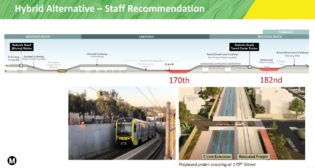
Claims of “myth” about rail preference seem mythical
Written by Lyndon HenryFortunately, especially in recent decades, the tide of public and official opinion has shifted dramatically. Since the 1970s, the Federal urban mass transit program has started funneling money not only to bolster existing rail systems but particularly to help start new ones. Local communities across the U.S. have formed public transit authorities to generate local money for both rail and bus projects and operations.
And as new rail systems have sprouted, the perception has grown that people really like riding trains more than buses. U.S. transit ridership has been hitting new records, with rail (especially light rail transit, LRT) leading the way in rates of ridership growth.
On the face of the evidence, it would seem that it has been the return of rail transit to U.S. cities that has spearheaded the return of urban populations back onto public transit. But curiously there’s a certain breed of nominal urban transit boosters who tend to disdain LRT and favor BRT, usually with some variant of “it’s just like light rail, but cheaper….”
A case in point is a recent article on the CityLab.com website (a project of The Atlantic magazine) authored by Eric Jaffe, a CityLab senior associate editor. As his headline declares, Jaffe takes aim at what he claims is “The Myth That Everyone Naturally Prefers Trains to Buses.” His main contention? “When you focus on what really matters—service—much of the difference actually disappears.”
Jaffe (and other similarly thinking bus advocates) seem to be claiming that if you just ran buses like trains, then people wouldn’t care what they were, but would simply hop on the buses just as much as they flock to trains. So why go to the expense of laying tracks and installing other rail infrastructure, when you can get the same result a lot cheaper by running just plain buses on pavement?
Jaffe’s article seems to rest most of its case on a couple of studies reported in papers authored by Australian David Hensher, a Professor of Management at the University of Sydney Business School, with colleagues. The most recent, published this January in the journal Transportation, described a project aimed at developing a model apparently trying to decipher “image preferences” between LRT and BRT. So, to 1,370 individuals in six major Australian cities, the researchers showed almost identical stylized images of a BRT bus and an LRT train at a station in a simulated street.
By far, LRT was overwhelmingly preferred in every city (even in cities with robust new BRT systems). On average, “modern LRT” beat out “modern BRT” by 55% to 17%. Jaffe finds these results “vexing” (how irritating, since he’s been repeatedly explaining how much better a choice BRT is?).
Also cited by Jaffe is a 2014 paper by Hensher et al., relating a study that involved asking 1,018 people in eight major Australian cities to evaluate a list of attributes for hypothetical LRT and BRT projects. As with the later “image” study, LRT was “predominantly preferred over BRT,” in this case “despite budgetary constraints, similarities in quality of service attributes and the opportunity to choose a greater network coverage for a given construction cost.” Vexed again!
So the researchers in the 2014 study asked respondents to select, from a prescribed list of choices, which features “really mattered” to them (Hensher calls this an application of “a semi-compensatory choice rule” to determine “attribute non-attendance”). Analyzing just the selected attributes that “mattered” out of the list, the researchers concluded that “modal bias” was “no longer a significant driver of preferences.”
So, no matter what you think you think, when you select what matters most out of our list, we prove that you really don’t think what you thought you were thinking at all. This seems either Kafkaesque or Orwellian. . . .
And there appear to be some basic methodological problems. As Australian public transport consultant Dudley Horscroft points out:
“So, given the full list of attributes, people prefer LRT. When you take away attributes that people apparently do not care about (the Attribute Non-Attendance Rule) the preference for LRT disappears. This is contradictory. If there are attributes that people consider irrelevant, then ignoring them should not alter the result. I wonder how [Hensher] came to his conclusion.”
But there are problems with Hensher’s attribute list itself—the researchers seem to have a thumb pressed on the scales of their survey, as several critical attribute assumptions appear skewed toward BRT. In the sample scenario presented to survey participants, LRT is accorded a third the route length of BRT, but over seven times the operation and maintenance cost, twice the peak headway, and four times the off-peak headway—plus a 40% higher fare differential! Yet LRT is assumed to have only a 50% dedicated alignment vs. 75% for BRT (a serious distortion of real-world conditions, where numerous “BRT” route segments in mixed traffic are commonplace).
Perhaps this bias toward BRT is not so shocking when one considers that Hensher’s paper itself describes his team’s work as “a contribution to the research program of the Volvo Research and Education Foundation Bus Rapid Transit Centre of Excellence,” acknowledged for “funding support” (a conflict-of-interest background that Jaffe’s article apparently didn’t feel obliged to mention—Volvo is a major bus manufacturer). Greg Sutherland, a Sydney professional engineer with broad experience at senior government levels in transport and logistics policy, operation, and design, characterizes Hensher’s “long standing reputation in Sydney” as “an apologist for the private bus industry.”
Summing up: The smoke-and-mirrors hocus-pocus in these kinds of efforts to disparage rail transit often involves rather dubious methodology cloaked in a haze of academic “truthiness.” In this case, the objective has evidently been to demonstrate that, despite their lying eyes (and their transit mode choice behavior), people really don’t prefer trains over buses at all. With LRT leading a surge of U.S. ridership growth (while bus ridership continues to drop), this magic act may face a very skeptical audience.



